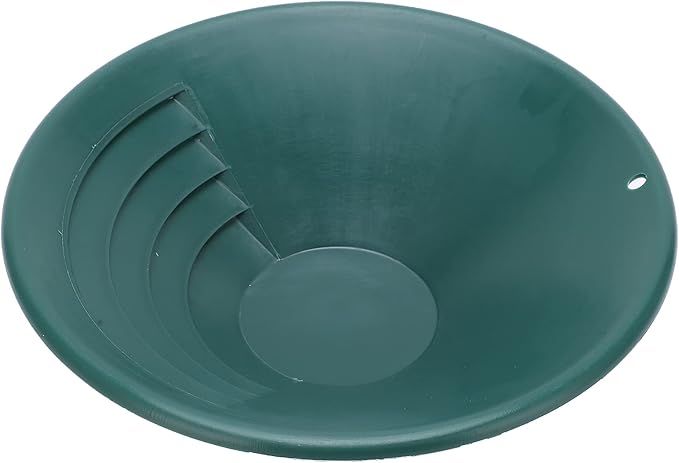Gold is a liquid asset, a resistant material and for some people even an investment. To fully understand this I will be writing about 3 aspects of Gold including The value of Gold, Gold as a material, How to test if your Gold is real. I will also include my favourite ways to utilise Gold. This post contains affiliate links if you purchase a product using the link I may make a commision at no extra cost to you.
The Value
For Gold to have value and to be sold there must be somebody willing to buy it. Why do people buy Gold? -Gold is a metal which does not rust, tarnish or corrode unlike other metals giving it the ability to exist and store wealth for centuries. The costly amount of labour needed to extract Gold from the earth makes the material expensive to buy from miners due to the labour cost. And finally Gold is a finite material on earth which makes it scarce and uncommon. All of these characteristics of Gold have turned it into the in-demand precious metal it has been for thousands of years. Arguably the biggest use of Gold has been using it to create jewellery so that people can wear the items created using the expensive metal. This is a good way to wear a fashionable and sought after product while it also retaining some of its value. Gold is associated with wealth and luxury in many cultures. The second most popular use is for the Gold to be left, most likely in a vault, for it to store value. This is usually done with Gold bars or coins. Most central banks still store Gold and the $ used to be backed by Gold until the controversial decision to remove the Gold standard which stopped the Dollar being backed by Gold so that the US government could print more money. This introduced the inflation of the Dollar and the increase of the Gold price. Lastly the 3rd main use of Gold is for actual uses as a material in several industries like electronics or for dentist products. This is a simple way of understanding the value of Gold throughout its timely usage.
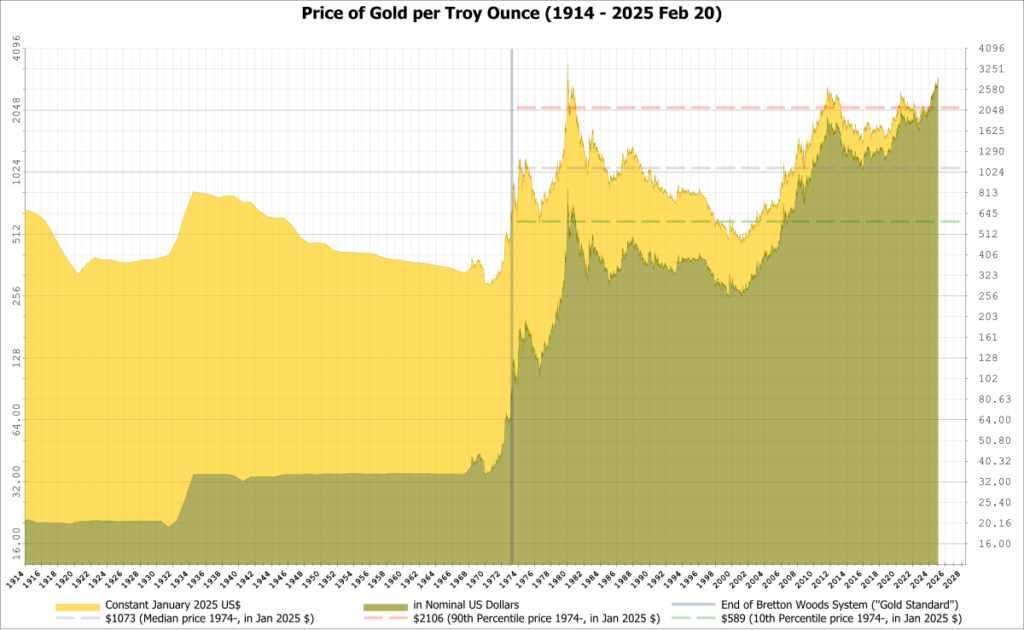
The price of Gold is volatile with it seeming to go up when the world has problems which lead investors into buying assets like Gold increasing the demand and price.
Gold as a Material
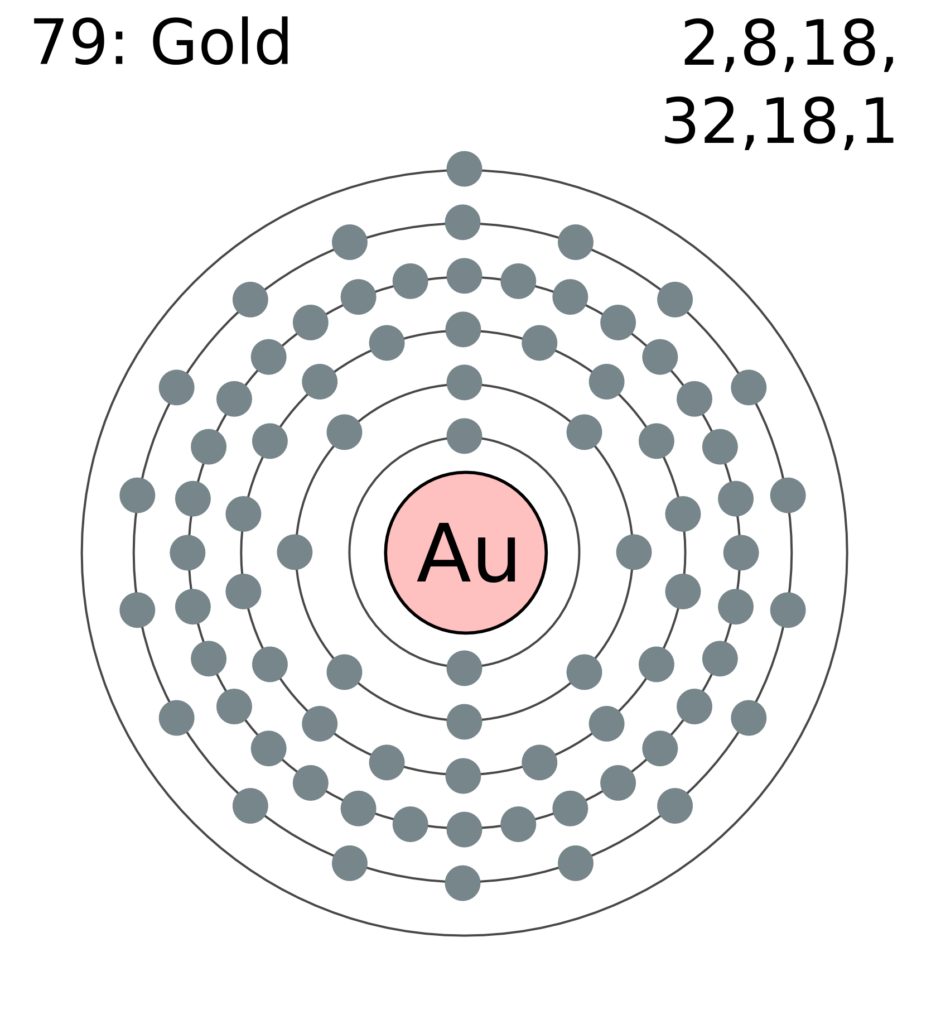
The basic things you need to know about Gold include the colours, Karat, authenticity and how to test the authenticity. Gold is naturally yellow when it is pure (24K) but when it is pure the material is weak and malleable meaning it doesn’t remain in a solid structure easily. This isn’t an issue if you are keeping Gold bars in a safe but it is when you are making Gold jewellery and Gold coins and trying to make them last in a solid structure as long as possible. After all the biggest % of Golds use is used for jewellery and as an asset. To have a metal used for jewellery and coins which is solid and contains Gold you must harden the gold with another metal. This usually changes the colour of the metal and decreases the percent of Gold in this new mix of Gold which is alloyed with a new metal. Karat is used as a measurement of the percentage of Gold in a metal. Karat for Gold is to not be mistaken for Carat which is for Diamond. This comes in 24 parts with 24 being 100% Gold and 18 being 75% and so forth. There are other scales which measure Gold fineness in parts other than 24 like the one which measures Gold purity with the highest being 999 used in the UK. Understanding Gold purity allows you to check a fair price of Gold. for example if the gold price is $100 per kilogram and you have a 1 kilogram gold piece of jewellery which is 12 karat’s the price should be around $50 and not $100 because 12 ÷ 24 = 0.5 Then $100 x 0.5 = 50. Of course this price may vary with the addition of labour costs and other added costs like taxes but this information still gives you a better understanding of the product.
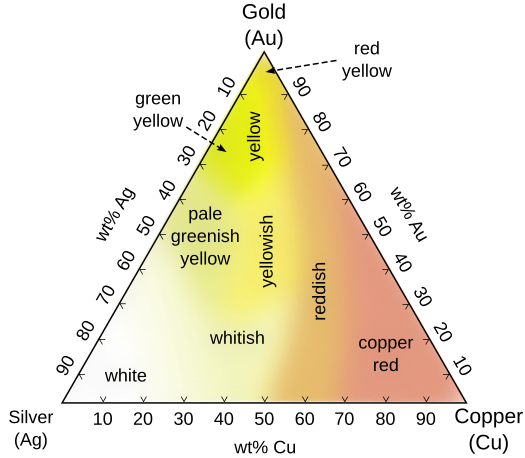
Alloying Gold with other elements also causes the product to change colour. The 3 most popular colours are Yellow, White and Copper red as seen in the triangle image above. The compositions of coloured gold can vary with the amount elements/metals that have been mixed with the Gold which can create a variety of different Gold colours and purity. This is why it’s so important to check the actual purity of metals before purchasing them especially gold. The 3 main Gold colours compositions may look like this as 18 Karat coloured Gold –
- Yellow – 75% Gold , 12.5% Silver , 12.5% Copper.
- White – 75% Gold , 25% Silver.
- Rose – 75% Gold , 25% Copper.
There can be a variety of compositions which make up these Gold colours even for it to still be considered 18 Karat but this should give you an idea of how alloying changes purity and colour. There are also other rarer colours which are not regularly seen but can still be achieved. One example is Blue coloured Gold which consists of Gold mixed with either indium or gallium. I won’t go over unique coloured Gold because they are rare and unpopular in my opinion but it is something that can exist which you should keep in mind.
Authenticity
Metals which are designed to look like Gold but contain none of the actual Gold material or obvious Fakes but there are less obvious products which could fool you into spending more money than you should. Gold plated, vermeil and gold filled have different names but are similar concepts. Gold plated and vermeil is a type of jewellery product which has a base metal which is usually a cheaper metal like copper or brass and then a tiny layer of Gold which is electroplated on top of the base metal. Electroplating uses electricity to bond a thin layer of metal onto another metal. The difference between the two names is the base metal. Vermeil has to have sterling silver (92.5% Silver) as the base metal while Gold plated uses cheaper metals like copper or brass. FTC standard for vermeil requires the use of sterling silver for the base, at least 10 karat Gold and the layer of Gold coating must be at least 2.5 microns thick. Keep in mind human hair is as thick as 80 microns. Gold plated is a similar product but consisting of a different cheaper base metal. Gold filled is similar but does not use electroplating instead the gold is rolled onto the base metal and bonds because of the pressure and heat it is subjected to. The issue with these types of jewellery compared to solid Gold is that it hold less value and it is more fragile. The thin layer of Gold will most likely not be worth a lot of money and that is if it is even preserved as this thin layer is likely to tarnish which will reveal the base metal underneath. With vermeil at least you do get silver as the base metal which does hold some value but keep in mind you will probably be overcharged for these types of products which would probably offset the small amount of value which these pieces might hold. On the other hand solid Gold ,being whatever Karat it is for example 18 Karat, is the same metal through the entire piece which means it holds more value and is easier to recycle or sell. Also if you damage a solid Gold piece it won’t tarnish in the same way as electroplated products. Finally Hollow Gold products is made up of Gold with a space in the middle therefore the name Hollow Gold. Jewellery made from Hollow Gold may make a weird noise and is less durable than solid Gold. In my opinion if you have a budget and you are getting a Hollow Gold piece for a reasonable price while understanding that it is less durable it is not too bad of an option if you really want to have some sort of Gold jewellery. While selling the jewellery item at a good price might be a bit harder you could still recycle the material and get a decent price for it. But this is why it is so important to get a fair price if you are buying a Hollow Gold Jewellery piece for this you need to consider the Karat and weight of the jewellery and the current Gold price at the time of buying. Ultimately the best jewellery in my opinion is solid Gold jewellery. Keep reading to learn how to test the authenticity of Gold so you can buy it for a fair price.
Testing Authenticity
One of the best ways to test if you have real Gold and find out the karat (purity) of the Gold is to use a Gold acid testing kit. These kits are really easy to understand and use while being one of the cheapest ways you can test Gold. The way this process works is that you have a testing stone which you can scratch your Gold on to leave a mark and then you lay down a drop of acid onto the scratch mark from your Gold. If the line disappears the Gold has failed the test for whichever karat you are testing. Usually you have a variety of acids which test for different Gold karats for example a 10K, 14K and an 18K acid test. If you were to test your Gold with the 14K acid test and the line dissolved this means the Gold is less than 14 karats pure. This does not mean there is not any Gold in the Jewellery you have tested it might be 10 Karats for example but with this result you can confidently conclude that the Gold is not 14 karats pure or any higher. If the Gold scratch mark does not dissolve when the acid is dropped onto it then this means the Gold pass’s whichever test you have used. If you are worried about inaccurate tests of your Gold due to this method only testing the surface of the Gold which is scratched onto the testing block than you can always break your jewellery so you are able to scratch the internal spacing of the jewellery. Although this is destructive this is one of the cheapest methods for testing the purity of your Gold throughout the entire structure to not be fooled by Gold plated products. These testing kits are regularly available on sites like Amazon.
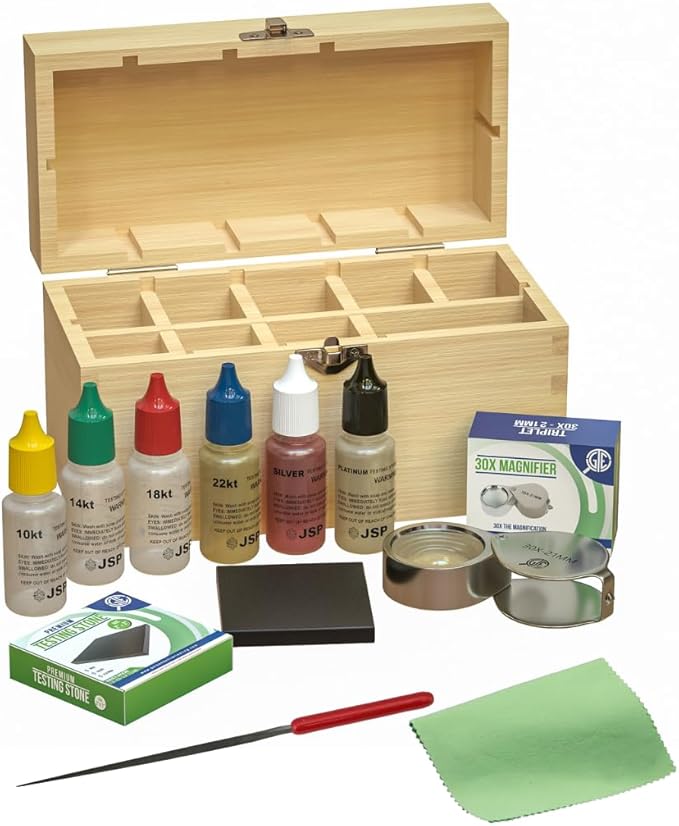
The next method for testing Gold is to use a Gold purity testing machine / karameter. These are more accurate than acid tests as they give you exact readings of the purity of your Gold. These machines are very complicated and subsequently very expensive. They use X-rays to accurately measure the chemical composition of the gold without having to break the Gold product to be able to test the purity of the internal structure. While these are very easy to use and efficient this technology is very expensive. If you work with a large amount of Gold regularly like if you are a jeweller then it might be worth it to invest in this sort of equipment. However if you are anybody else I would not recommend spending thousands on this equipment if you are only going to use it a couple of times. If you are looking to get an accurate reading of your Gold using this equipment without spending thousands then visit a jeweller which owns this sort of equipment and get it tested there.
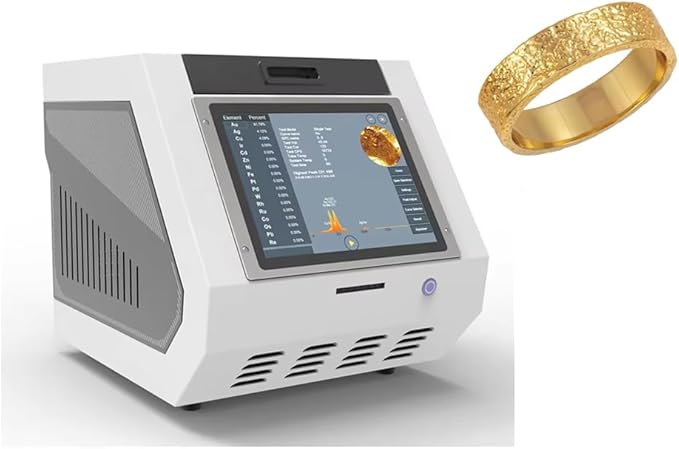
Using Gold To Your Advantage
As you can tell Gold is a valuable and an important material. Here are my favourite methods to utilise Gold. 1- manufactured spending using gold –
This method involves circulating money through a credit card to maximise on the point rewards which gives you access to free flights, cashback or luxury spending. Step 1- is to pick the right credit card which ideally gives you points for spending or a good cashback rate and avoid cards which classify gold as a cash advance. Step 2- is to find retailers or grocery stores which sell gold which you can buy using your card. Step 3- is to buy Gold under suspicious amounts at the stores using your credit card. Step 4- is to liquidate the gold by selling it at a minimal loss or even a gain which is optimal. Finally use the money from selling the gold to pay back the debt in time on the card while keeping the points from when you bought the gold with your card = Free money. This is a simplified explanation of manufactured spending with a credit card.
The last method I want to talk about is a well known traditional way of finding gold which could potentially earn you a decent amount of money with some luck mixed with hard work. Gold panning has been used for centuries to find Gold and if your in the right area you should really think about starting it. It starts by you finding the right riverbed to search in. You could do some basic research of how to recognise spots where gold piles up in rivers. Gold is very heavy so it will always sink to the bottom of any sand or dirt it is mixed with which is one of the core ideas of Gold panning. Once you recognise a good spot like a spot in the river with black sand you can start collecting sediment and sifting through it to potentially find gold at the bottom where it sinks to. If you are interested in this I recommend you do some more research into this topic to truly understand the skills of finding the correct spots and how to sift through sediment. I will have a more detailed blog on this topic but all you really need to begin is a Gold pan as seen below and a shovel.
